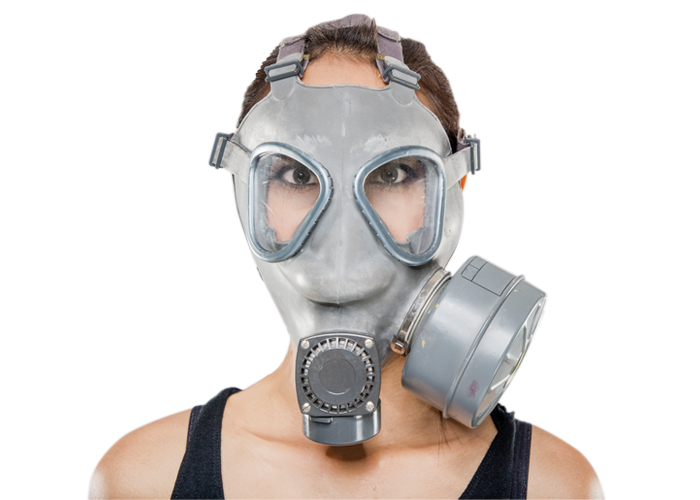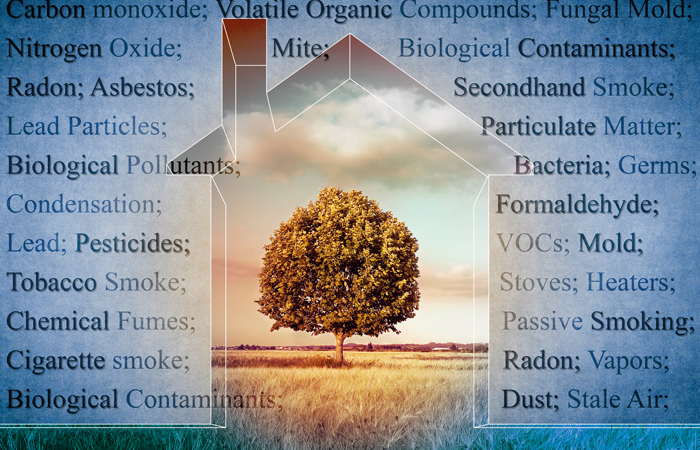The air that we breathe
In OTC
Follow this topic
Bookmark
Record learning outcomes

Outdoor air pollution is on everyone’s radar, but indoor air pollution also poses many risks. So how can pharmacy customers be advised to make improvements in their home to benefit their health?
Many people are well aware that outdoor air pollution carries significant health risks, but what’s less widely known is that indoor air pollution can be toxic to people’s health too. Recent research by pharmaceutical aromatherapy brand Puressentiel found that 63 per cent of Brits hadn’t heard of indoor air pollution, 83 per cent of them didn’t worry about it and only 20 per cent said they took action to improve the air within their home. Yet most people spend 90 per cent of their time indoors and are exposed to a wide range of invisible air pollutants.
“Research indicates that indoor air pollution has a significant impact on health,” says Professor Stephen Holgate, co-chair of the recently formed Royal College of Physicians Working Party on Indoor Air Pollution and Children’s Health. “We estimate that this is up to 9,000 deaths per year of the estimated total of 40,000 deaths from air pollution overall each year in the UK.”
What causes indoor air pollution?
Some indoor pollutants enter from outside, but many are generated indoors. Some pollutants, like carbon monoxide, are produced by faulty equipment, such as gas cookers and boilers, but others are produced by normal day-to-day gadgets, machinery and activities.
“Many of us spend most of our time indoors and this makes good indoor air quality especially important,” says chemist and medical herbalist Chris Etheridge. “One of the worries is that indoor pollution is a cocktail of outdoor pollutants, such as ozone and vehicle emissions, and indoor irritants, such as volatile organic compounds, cleaning chemicals, moulds, fungal spores and bacteria, and we really don’t understand the long-term health implications of this sort of multiple exposure. Many people aren’t aware of indoor air pollution and what it is, so we need to get this information into the public sector.”
According to the Government’s Clean Air Strategy 2019, the main forms of indoor air pollution are particulate matter (hazardous particles suspended in the air) and non-methane volatile organic compounds (NMVOCs). Burning wood and coal in open fires and stoves – which are now an additional source of heating for many households in both urban and rural areas – makes up 38 per cent of the UK’s primary emissions of fine particulate matter – this compares with industrial combustion at 16 per cent and road transport at 12 per cent.
According to the Clean Air Strategy 2019, if a product has a strong smell, there is a good chance it contains NMVOCs. These organic compounds, including benzene and formaldehyde, evaporate into the air at room temperature from a wide variety of chemicals in carpets; upholstery; paint; and cleaning, fragrance and personal care products – even household candles. Many NMVOCs have low levels of toxicity on their own, but may react in the air to form other chemicals that are much more harmful when breathed in. If ventilation indoors is poor, NMVOC levels are more likely to build up.
Smoking is a well-known source of air pollution, but research shows that e-cigarettes can emit pollutants as well. This can affect indoor air quality with potentially adverse health effects, many of which are still not fully known.
Biological pollutants, such as dust mites and mould, can also be a problem, especially in damp buildings. Indoor air pollution exists all year around but airborne allergens expert Max Wiseberg says that it tends to be worse in the winter when doors and windows remain closed. “This means dust and indoor allergens have nowhere to go,” he says. “Drying clothes indoors can create an abundance of mould spores, which add to the problem. Although the spring and summer brings more open windows, which helps to circulate the air, dissipating some of the indoor pollution, it also allows pollen to come inside.”
Who is at risk?
According to the British Lung Foundation, poor indoor air quality has been linked to lung diseases such as asthma, chronic obstructive pulmonary disease (COPD) and lung cancer. Some indoor air pollutants don’t cause specific symptoms, especially at low levels, although carbon monoxide can cause headaches, dizziness, nausea and shortness of breath. If someone develops an allergy, they may notice itchy eyes or throat, sneezing, a runny nose with clear nasal discharge and inflamed, swollen sinuses. If they have asthma, their symptoms may get worse.
According to Allergy UK, good indoor air quality is particularly important for vulnerable groups, such as babies, children, the elderly and anyone with a respiratory or allergic disease. However, air pollutants can act on other parts of the body too, especially in people suffering from heart disease, congestive heart failure or coronary artery disease. Research shows that air pollution can damage, narrow and harden the inside walls of blood vessels; restrict movement of blood vessels, which increases blood pressure; and make blood more likely to clot. In August 2018, research published in the journal Circulation linked exposure to nitrogen dioxide and fine particulate matter to an increase in the size of the heart’s left and right ventricles. This could make existing heart conditions worse or lead to a heart attack, stroke or new health condition, such as arrhythmias and angina. There’s also increasing evidence that air pollution may affect the brain and is possibly linked to dementia and cognitive decline.
Practical advice
One of the Government’s Clean Air Strategy 2019 recommendations is to raise awareness of everyday activities that contribute to indoor air pollution. This year’s Clean Air Day – taking place on 20 June – is the UK’s largest air pollution campaign. Behaviour change charity Global Action Plan is encouraging people to take part through local events and on social media. One way that community pharmacies can get involved is to run their own awareness event using downloadable resources, including a toolkit for healthcare professionals. This could tie in with the promotion of relevant products, such as fragrance-free or naturally scented air fresheners and cleaning products, dehumidifiers and allergy medicines and remedies.
Pharmacy staff can ask customers at the counter if they’re aware of the dangers of indoor air pollution and offer helpful advice, in particular targeting some of the high-risk groups, especially those with existing respiratory conditions.
Tips that can be passed on to pharmacy customers include:
- Open a window and/or use an extractor fan when cooking, bathing or using cleaning products
- Service the boiler and other gas appliances at least once a year to make sure there’s no carbon monoxide leakage and install carbon monoxide detectors
- Switch to low VOC products – use fragrance-free or naturally scented products, mild cleaning products and avoid aerosols
- Burn smokeless fuels or dry, well-seasoned wood on a Defra-approved wood-burning stove and make sure the room is well ventilated
- Consume less energy by switching off the lights, filling the kettle with just what is needed and only running the washing machine and dishwasher when there is a full load
- Recycle compostables rather than burning them – turn them into food for a vegetable patch, for example
- Keep humidity in the home low to keep dust mites, mould spores and other allergens at bay; fix any leaks; and use a dehumifier if there is a damp problem
- When drying clothes indoors, keep the door to the rest of the home shut and the window of the drying room open
- When living near a busy road, keep the windows shut at the specific times of the day when pollution levels are high (e.g. during rush hour). There are a number of websites and apps that can send alerts when high pollution days are expected.
Air pollution and ageing

It’s well known that certain environmental factors can damage the skin, especially ultraviolet (UV) light from the sun. But increasingly, research is showing that air pollutants, such as particulate matter and volatile organic compounds (VOCs), can have adverse effects on skin health, potentially leading to long-term damage. Scientists believe that the upper layers of the skin rely on oxygen absorption to produce collagen, which is essential for elasticity and healing. It’s unclear exactly how air pollution damages the skin, but suggested mechanisms include the generation of harmful free radicals triggering inflammation and changing the skin’s natural bacteria levels.
In a recent Puressentiel survey, only one in six people were aware of a link between air pollution and premature skin ageing and only one in 10 associated pollution with wrinkles. “On a basic level, pollutants can block pores and leave skin feeling grimy and dirty,” says Katharine Mackenzie Paterson, skincare specialist and adviser to Puressentiel. “At least one large epidemiology study has shown a link between high pollution levels and acne. But there is also compelling evidence that pollutants accelerate ageing, increase the risk of atopic skin problems such as dermatitis and eczema and may drive the DNA damage associated with melanoma. So, it makes sense to try to reduce your exposure to pollutants and protect against the damage they can cause.”
To protect the skin from indoor and outdoor air pollution, especially if they already have a chronic skin condition, pharmacy customers should be advised to:
- Clean skin twice a day and remove any make-up
- Keep skin well-moisturised, day and night, to help form a barrier between the skin and the polluted atmosphere
- Limit exposure to anything that could make the skin more sensitive, such as extreme temperatures, irritant chemicals, excessive bathing, known allergens (such as nickel), excessive sunlight and emotional stress
- Eat foods that are rich in antioxidants and healthy fats
- Use any medications for chronic skin conditions as prescribed to limit the risk of flare-ups.
